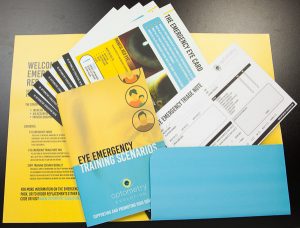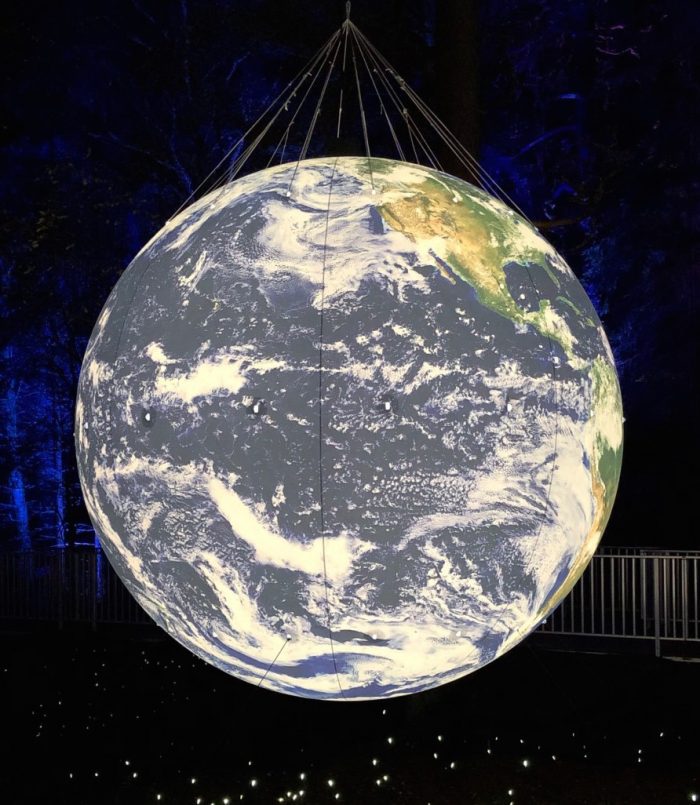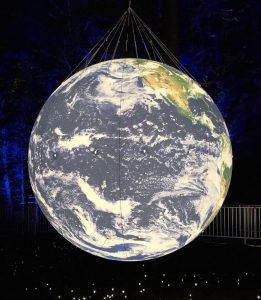
Welcome to this latest Optometry-Evolution article, which sees me going off-piste, away from the usual clinical topics. In every aspect of modern life there has been a real shift in our consciousness of issues relating to the environment, touching on a range of challenges from emissions, plastics, waste management, how we recycle and reuse, energy efficiency and a whole lot more. David Attenborough’s recent campaigns in particular have had a huge impact on how we view and use plastics – I now find myself stuffing unrecyclable plastic packaging into plastic bottles with a wooden spoon to form a dense ‘plastic brick’ which can be put to all sorts of structural uses which can be seen here – www.ecobricks.org.
I thought it would be really interesting to start a discussion through optometry social media in the UK to explore what measures people are currently taking to try to minimise the environmental footprint of modern optometry practice. The response was really great, with a whole range of strategies that I will aim to share in this article.
There are various key areas where people responded to this online discussion:
Contact lenses
Disposable plastic products have really come under the spotlight recently which forces us to look at contact lens consumption from an environmental perspective. Clinically daily lenses are great from an infection risk perspective and for patient convenience, but they certainly add to the estimated 780million lenses used in the UK each year. The vast majority of these end their short lives being cast off down the sink, toilet or into landfill. The associated boxes and packaging also needs to be disposed of, with the majority heading to landfill. Clearly those lenses going into water systems can cause serious problems, with a risk of them ending up in the natural ecosystem. 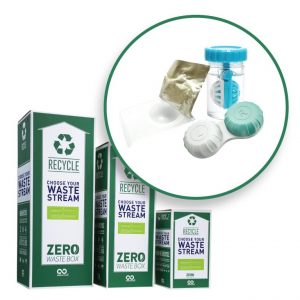 One of the most common responses I gained from the online discussion was the installation of recycling boxes in optometry practice which aim to take all the materials of lenses and packaging for recycling and reuse. The plastics can be returned into plastic pellet form for use in other products and the cardboards can end up being recycled or composted. One such scheme is run by Terracyle in conjunction with Acuvue, and at present they have 1229 UK practices up and running with this. I believe Bausch and Lomb also run a similar scheme for lens recycling. One of the UK chains Optical Express highlighted that they have been running a contact lens recycling scheme and trying to improve patient’s habits when it comes lens disposal.
One of the most common responses I gained from the online discussion was the installation of recycling boxes in optometry practice which aim to take all the materials of lenses and packaging for recycling and reuse. The plastics can be returned into plastic pellet form for use in other products and the cardboards can end up being recycled or composted. One such scheme is run by Terracyle in conjunction with Acuvue, and at present they have 1229 UK practices up and running with this. I believe Bausch and Lomb also run a similar scheme for lens recycling. One of the UK chains Optical Express highlighted that they have been running a contact lens recycling scheme and trying to improve patient’s habits when it comes lens disposal.
In a similar vein to disposable lenses, eye-drops for various conditions have seen a large shift towards single-dose units over the past few years, to allow for preservative free products. Clinically these are really beneficial particularly when it comes to dry-eye products and some glaucoma products, and in some cases these may be the only treatments patients tolerate. The downside however, which was highlighted in a debate I saw at a glaucoma meeting between two consultants for and against preservative free preparations, is the additional waste materials involved in delivering single dose units.
Spectacles
An independent optometrist in Durham, Simon berry has done a lot of work in the area of ethical sourcing and sustainability. In 2017 he wrote an article in optician magazine which is well worth a look. He highlights the limitations of recycling when it comes to most pairs of spectacles. The vast majority will end up in landfill. Charities such as Vision Aid Overseas will reuse spectacles by cleaning, repairing and grading them for use in projects in developing countries which extends their use in a very positive and worthwhile way. But even this, Simon points out has its limitations. Only around 1 in 15 pairs of donated specs end up being suitable for use, then once you factor in the costs of packaging and transport to their location of use, this is less efficient than producing spectacles in the place of intended use.
There are some companies which are taking a novel look at spectacle production. Faye MacDearmid in Redcar pointed out a range by ‘Neubau’ which uses natural materials based on castor oil rather than traditional acetate in order to reduce waste production and enhance sustainability.
Other companies manage to kill two birds with one stone (if that can be done in an environmentally responsible way) by reclaiming waste plastics from the seas in order to manufacture spectacle frames.
Waterhaul, which is a company based in Cornwall have been doing just that – producing sunglasses and spectacle frames made from plastic debris collected by their partner organisations. You can find out more about Waterhaul and their mission to produce functional equipment from ocean plastic and fishing nets at their website.
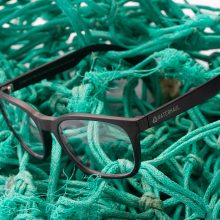
In Europe Sea2See have being doing similar work. Other materials such as wood and bamboo have also been used more recently to produce spectacle frames in a more sustainable fashion.
In terms of lens production – Michael O’Kane of Specsavers in Edinburgh highlighted their glazing technology which has advanced systems for filtering the water involved, so that one tank of water can be continually used, rather than a constant source of water running through the machine. Again if you multiply this up across our industry and the number of machines, the water saving could be very significant. Consider this in countries where water conservation is a more pressing issue than it perhaps is here in Scotland (in December) then this type of technology is surely a great step in the right direction.
One of the best suggestions was an optometrist in South Africa asking if anyone knew how to turn waste CR39 into Gas? I suspect this could be very lucrative, but question whether the environmental credentials of such a scheme would stack up!
One final thought I had was on the topic of spectacles was the number of pairs produced as part of 2 for 1 offers. What percentage of these second pairs perhaps end up never being used? This might make an interesting audit or project for an optometry student out there. Our industry is now very commercially competitive and these offers I appreciate might be crucial from a business perspective, but wonder if in time whether there will be a shift in tis approach?
Technology and equipment
A lot of our core equipment has probably become more efficient in recent years – slit lamps now employ LED lighting systems rather than traditional tungsten. This is beneficial in two ways, in that less heat is produced with LED and this system does not require the same degree of bulb replacement as tunsgten.
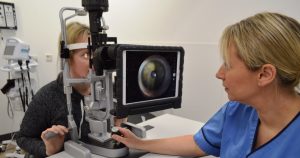
An innovative way of potentially reducing the environmental burden of patients travelling to eye clinics, particularly in the hospital setting, has been developed by Forth Valley ophthalmologist, Dr Iain Livingstone. He has been working to develop an adapted i-pad that can be attached to a slit lamp in order to transmit a high quality live video stream of an eye examination to where the relevant clinician is located. This might allow for consultations to be carried out between different centres to allow a sub-specialist review a patient, or it may help in a remote and rural setting such as the Highlands and Islands region of Scotland where I work. Eye casualty cases could maybe be triaged and indeed examined at a distance, often saving the patient a 6 hour round trip, and in some cases a flight.
With respect to our consumable kit, I remember about 12 years ago attending a lecture on the need to transition from reusable Goldmann tonometer prisms to disposable plastic tips due to the risk of transmitting CJD and other diseases.
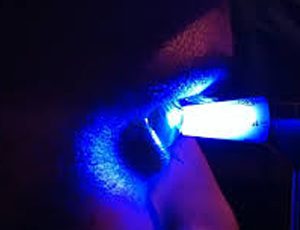
At the time I wondered if all the extra materials, costs, packaging was proportional to the actual risk of disease transmission, so I put my hand up and basically asked this question. Later in the talk the speaker referred to me as the ‘young environmentalist in the front,’ which I felt implied that the increased waste was a marginal consideration. I think nowadays this would be the first question for a lot people, which represents a very positive cultural shift. The move from any piece of equipment to a disposable version should be scrutinised. In recent years gonioscopy lenses have also been developed in disposable form – which removes the cleaning element to minimise the risk of transmissible disease. I do a lot of hospital glaucoma clinics, and such a change would require me to use several hundred lenses each year, where actually one seems to suffice.
General Domestic Factors

There were a lot of general tips that people cited in the online discussions. Lots of practices have reverted to LED lighting systems and are using electricity suppliers who source their power from renewable production methods. A huge move towards paperless working also helps in terms of reducing paper and printing related consumption. One tip that I wasn’t expecting, and I apologise for not remembering who highlighted this was ‘how to dry your hands with one paper-towel!’ You can become inexpert by watching this short Youtube video.
Also a lot of discussion around the sourcing and movement of supplies, with the aim of minimising miles travelled between source and eventual place of sale and use. Purchasing and sourcing supplies as locally as possible.
One final measure for energy conservation I thought of was to limit staff members to making one cup of tea or coffee a day…………….however optometry practices across the land along with the NHS eye clinics might just crumble!
We don’t have to be experts on environmental science and climate change, and I certainly don’t claim to be, but it does strike me that there are a lot of common sense and fairly logical things we can all do in our clinical life that can at least try to limit our. environmental foot-print. I hope this article has given plenty of food for thought. As usual any comments are welcome.
Thank you as always for reading!
Stan
